2001 CHRYSLER VOYAGER relay
[x] Cancel search: relayPage 4102 of 4284

TABLE OF CONTENTS - Continued
TRANSMISSION
P0120-THROTTLE POSITION SENSOR SIGNAL CIRCUIT.....................24
P0600-SERIAL COMMUNICATION LINK MALFUNCTION.......................26
P0604-INTERNAL TCM..................................................28
P0605-INTERNAL TCM..................................................29
P0700-INTERNAL TCM..................................................30
P0705-CHECK SHIFTER SIGNAL..........................................31
P0715-INPUT SPEED SENSOR ERROR....................................38
P0720-OUTPUT SPEED SENSOR ERROR..................................42
P0725-ENGINE SPEED SENSOR CIRCUIT (3.3L/3.8L)........................46
P0725-ENGINE SPEED SENSOR CIRCUIT (3.5L)............................48
P0731-GEAR RATIO ERROR IN 1ST.......................................51
P0732-GEAR RATIO ERROR IN 2ND.......................................53
P0733-GEAR RATIO ERROR IN 3RD.......................................55
P0734-GEAR RATIO ERROR IN 4TH.......................................57
P0736-GEAR RATIO ERROR IN REVERSE..................................59
P0740-TORQUE CONVERTER CLUTCH CONTROL CIRCUIT...................61
P0750-LR SOLENOID CIRCUIT............................................63
P0755-2-4 SOLENOID CIRCUIT...........................................66
P0760-OD SOLENOID CIRCUIT...........................................69
P0765-UD SOLENOID CIRCUIT...........................................72
P1714-LOW BATTERY VOLTAGE..........................................75
P1716-BUS COMMUNICATION WITH PCM..................................79
P1717-NO COMMUNICATION WITH THE MIC...............................81
P1738-HIGH TEMPERATURE OPERATION ACTIVATED.......................83
P1739-POWER UP AT SPEED............................................85
P1765-SWITCHED BATTERY.............................................86
P1767-TRANSMISSION RELAY ALWAYS ON................................89
P1768-RELAY OUTPUT ALWAYS OFF......................................92
P1775-SOLENOID SWITCH VALVE LATCHED IN TCC POSITION...............96
P1776-SOLENOID SWITCH VALVE LATCHED IN LR POSITION................100
P1781-OD PRESSURE SWITCH SENSE CIRCUIT...........................104
P1782 - 2-4 PRESSURE SWITCH SENSE CIRCUIT..........................107
P1784-LR PRESSURE SWITCH SENSE CIRCUIT...........................110
P1787-OD HYDRAULIC PRESSURE TEST FAILURE.........................114
P1788-2/4 HYDRAULIC PRESSURE TEST FAILURE.........................118
P1789-2-4/OD HYDRAULIC PRESSURE TEST FAILURE......................122
P1790-FAULT IMMEDIATELY AFTER SHIFT................................123
P1791-LOSS OF PRIME.................................................124
P1792-BATTERY WAS DISCONNECTED...................................127
P1793-TRD LINK COMMUNICATION ERROR...............................130
P1794-SPEED SENSOR GROUND ERROR................................133
P1795-INTERNAL TCM.................................................135
P1796-AUTOSTICK SENSOR CIRCUIT....................................136
P1797-MANUAL SHIFT OVERHEAT.......................................139
P1798-WORN OUT/BURNT TRANSAXLE FLUID.............................140
P1799-CALCULATED OIL TEMP IN USE...................................142
*BRAKE SHIFT INTERLOCK OUTPUT OPEN...............................146
*CHECKING PARK/NEUTRAL SWITCH OPERATION.........................148
*INCORRECT TRANSMISSION FLUID LEVEL...............................150
*NO BACK UP LAMP OPERATION........................................151
*NO SPEEDOMETER OPERATION........................................153
*TRANSMISSION NOISY WITH NO DTC'S PRESENT........................154
ii
Page 4103 of 4284

TABLE OF CONTENTS - Continued
*TRANSMISSION SHIFTS EARLY WITH NO DTC'S..........................155
*TRANSMISSION SIMULATOR 8333 WILL NOT POWER UP..................156
VERIFICATION TESTS
VERIFICATION TESTS..................................................157
8.0 COMPONENT LOCATIONS..............................................159
8.1POWERTRAIN CONTROL MODULE..................................159
8.2TRANSMISSION CONTROL MODULE................................159
8.3INTELLIGENT POWER MODULE....................................159
8.4PRESSURE PORT LOCATIONS.....................................160
8.5THROTTLE POSITION SENSOR (2.4L)...............................160
8.6AUTOSTICK/OD OFF..............................................160
8.7TRANSMISSION COMPONENT LOCATIONS..........................161
9.0 CONNECTOR PINOUTS................................................163
AUTOSTICK SWITCH - BLACK 2 WAY.....................................163
BODY CONTROL MODULE C2 - BLACK/GREEN 34 WAY.....................163
BRAKE LAMP SWITCH - BLACK 6 WAY...................................164
CRANKSHAFT POSITION SENSOR - BLACK 3 WAY.........................164
DATA LINK CONNECTOR - WHITE 16 WAY................................164
DIAGNOSTIC JUNCTION PORT - BLACK 16 WAY...........................165
INPUT SPEED SENSOR (3.3L/3.8L) - GRAY 2 WAY..........................165
INTELLIGENT POWER MODULE C3 - NATURAL 20 WAY.....................165
INTELLIGENT POWER MODULE C4 - GRAY 10 WAY........................166
INTELLIGENT POWER MODULE C5 - BLACK 4 WAY........................166
INTELLIGENT POWER MODULE C6 - WHITE 10 WAY.......................166
INTELLIGENT POWER MODULE C7 - BLACK 20 WAY.......................167
INTELLIGENT POWER MODULE C9 - BLACK 10 WAY.......................167
LEFT REAR LAMP ASSEMBLY - BLACK 6 WAY.............................167
OUTPUT SPEED SENSOR (3.3L/3.8L) - GRAY 2 WAY........................168
PARK/NEUTRAL POSITION SWITCH (2.4L) - BLACK 3 WAY..................168
FUSES (IPM)..........................................................170
TRANSMISSION SAFETY SHUTDOWN RELAY.............................170
POWERTRAIN CONTROL MODULE C1 - GRAY/BLACK 40 WAY...............171
POWERTRAIN CONTROL MODULE C2 - GRAY/GRAY 40 WAY................172
RIGHT REAR LAMP ASSEMBLY - BLACK 6 WAY............................172
SOLENOID/PRESSURE SWITCH ASSEMBLY (3.3L/3.8L) - BLACK 8 WAY.......173
THROTTLE POSITION SENSOR - GRAY 3 WAY............................173
TORQUE CONVERTER CLUTCH SOLENOID (2.4L) - BLACK 3 WAY...........173
TRANSMISSION CONTROL MODULE (3.3L/3.8L) - BLACK 60 WAY............174
TRANSMISSION RANGE SENSOR (3.3L/3.8L) - GRAY 10 WAY................175
10.0 SCHEMATIC DIAGRAMS................................................177
iii
Page 4105 of 4284

1.0 INTRODUCTION
The procedures contained in this manual include
all of the specifications, instructions, and graphics
needed to diagnose 41TE/AE Electronic Automatic
Transaxle (EATX) problems. The diagnostics in this
manual are based on the failure condition or symp-
tom being present at the time of diagnosis.
When repairs are required, refer to the appropri-
ate volume of the service manual for the proper
removal and repair procedure.
Diagnostic procedures change every year. New
diagnostic systems may be added and/or carryover
systems may be enhanced. READ THIS MANUAL
BEFORE TRYING TO DIAGNOSE A VEHICLE
TROUBLE CODE. It is recommended that you
review the entire manual to become familiar with
all new and changed diagnostic procedures.
This book reflects many suggested changes from
readers of past issues. After using this book, if you
have any comments or recommendations, please fill
out the form at the back of the book and mail it back
to us.
1.1 SYSTEM COVERAGE
This diagnostic procedures manual covers all
2001 RG equipped with a 41TE/AE transaxle.
1.2 SIX -STEP TROUBLESHOOTING
PROCEDURE
Diagnosis of the 41TE/AE electronic transaxle is
done in six basic steps:
verification of complaint
verification of any related symptoms
symptom analysis
problem isolation
repair of isolated problem
verification of proper operation
2.0 IDENTIFICATION OF
SYSTEM
RG series vehicles equipped with a 4 speed trans-
mission.
3.0 SYSTEM DESCRIPTION AND
FUNCTIONAL OPERATION
3.1 GENERAL DESCRIPTION
The 41TE/AE electronic transaxle is a conven-
tional transaxle in that it uses hydraulically ap-
plied clutches to shift a planetary gear train. How-
ever, the electronic control system replaces many of
the mechanical and hydraulic components used in
conventional transmission valve bodies.
3.2 FUNCTIONAL OPERATION
The 41TE/AE electronic transaxle has a fully
adaptive control system. The system performs it's
functions based on continuous real-time sensor
feedback information. The control system automat-
ically adapts to changes in engine performance and
friction element variations to provide consistent
shift quality. The control system ensures that clutch
operation during upshifting and downshifting is
more responsive without increased harshness.
The Transmission Control Module (TCM) contin-
uously checks for electrical problems, mechanical
problems, and some hydraulic problems. When a
problem is sensed, the TCM stores a diagnostic
trouble code. Some of these codes cause the tran-
saxle to go into limp-in or default mode.
While in this mode, electrical power is taken
away from the transaxle via the TCM, de-
energizing the transmission control relay, and tak-
ing power from the solenoid pack. When this hap-
pens, the only transaxle mechanical functions are:
Park and Neutral
Reverse
Second Gear
No upshifts or downshifts are possible. The posi-
tion of the manual valve alone allows the three
ranges that are available. Although vehicle perfor-
mance is seriously degraded while in this mode, it
allows the owner to drive the vehicle in for service.
Once the DRBIIItis in the EATX portion of the
diagnostic program, it constantly monitors the
TCM to see if the system is in limp-in mode. If the
transaxle is in limp-in mode, the DRBIIIž will flash
the red LED.
3.2.1 AUTOSTICK FEATURE
This feature allows the driver to manually shift
the transaxle when the shift lever is pulled back
into the AutoStick position. When in AutoStick
mode, the instrument cluster displays the current
gear.
1
GENERAL INFORMATION
Page 4108 of 4284
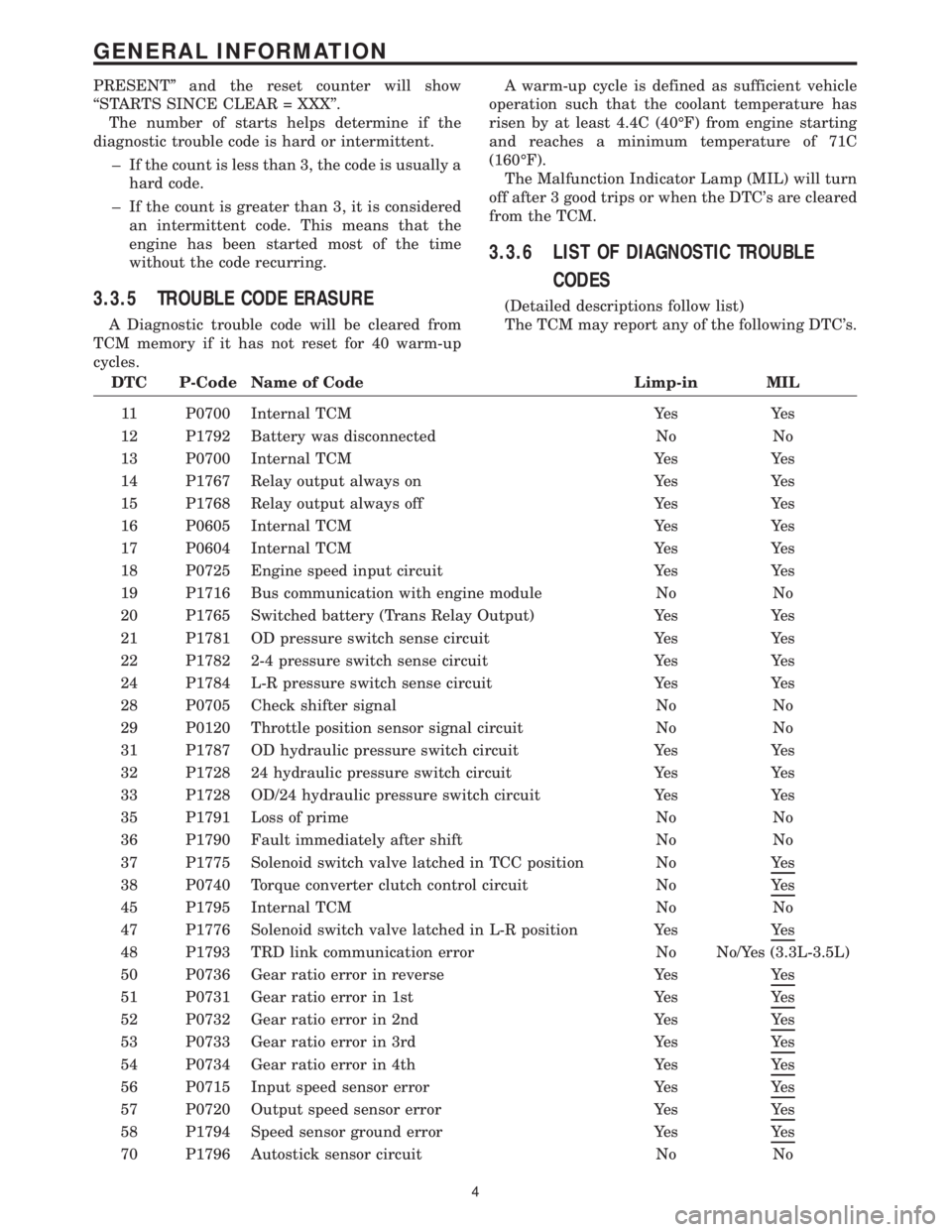
PRESENT'' and the reset counter will show
``STARTS SINCE CLEAR = XXX''.
The number of starts helps determine if the
diagnostic trouble code is hard or intermittent.
± If the count is less than 3, the code is usually a
hard code.
± If the count is greater than 3, it is considered
an intermittent code. This means that the
engine has been started most of the time
without the code recurring.
3.3.5 TROUBLE CODE ERASURE
A Diagnostic trouble code will be cleared from
TCM memory if it has not reset for 40 warm-up
cycles.A warm-up cycle is defined as sufficient vehicle
operation such that the coolant temperature has
risen by at least 4.4C (40ÉF) from engine starting
and reaches a minimum temperature of 71C
(160ÉF).
The Malfunction Indicator Lamp (MIL) will turn
off after 3 good trips or when the DTC's are cleared
from the TCM.
3.3.6 LIST OF DIAGNOSTIC TROUBLE
CODES
(Detailed descriptions follow list)
The TCM may report any of the following DTC's.
DTC P-Code Name of Code Limp-in MIL
11 P0700 Internal TCM Yes Yes
12 P1792 Battery was disconnected No No
13 P0700 Internal TCM Yes Yes
14 P1767 Relay output always on Yes Yes
15 P1768 Relay output always off Yes Yes
16 P0605 Internal TCM Yes Yes
17 P0604 Internal TCM Yes Yes
18 P0725 Engine speed input circuit Yes Yes
19 P1716 Bus communication with engine module No No
20 P1765 Switched battery (Trans Relay Output) Yes Yes
21 P1781 OD pressure switch sense circuit Yes Yes
22 P1782 2-4 pressure switch sense circuit Yes Yes
24 P1784 L-R pressure switch sense circuit Yes Yes
28 P0705 Check shifter signal No No
29 P0120 Throttle position sensor signal circuit No No
31 P1787 OD hydraulic pressure switch circuit Yes Yes
32 P1728 24 hydraulic pressure switch circuit Yes Yes
33 P1728 OD/24 hydraulic pressure switch circuit Yes Yes
35 P1791 Loss of prime No No
36 P1790 Fault immediately after shift No No
37 P1775 Solenoid switch valve latched in TCC position No Yes
38 P0740 Torque converter clutch control circuit No Yes
45 P1795 Internal TCM No No
47 P1776 Solenoid switch valve latched in L-R position Yes Yes
48 P1793 TRD link communication error No No/Yes (3.3L-3.5L)
50 P0736 Gear ratio error in reverse Yes Yes
51 P0731 Gear ratio error in 1st Yes Yes
52 P0732 Gear ratio error in 2nd Yes Yes
53 P0733 Gear ratio error in 3rd Yes Yes
54 P0734 Gear ratio error in 4th Yes Yes
56 P0715 Input speed sensor error Yes Yes
57 P0720 Output speed sensor error Yes Yes
58 P1794 Speed sensor ground error Yes Yes
70 P1796 Autostick sensor circuit No No
4
GENERAL INFORMATION
Page 4109 of 4284
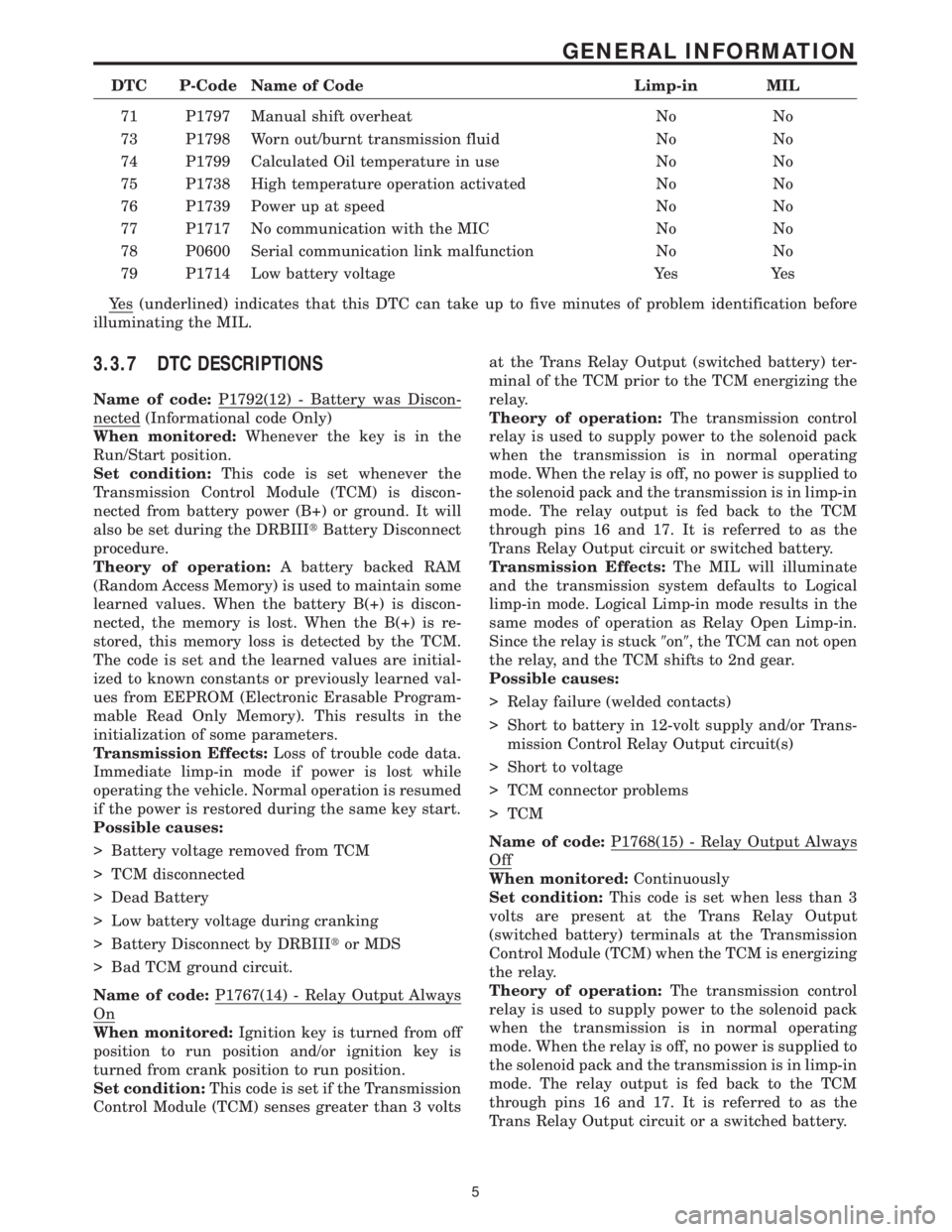
DTC P-Code Name of Code Limp-in MIL
71 P1797 Manual shift overheat No No
73 P1798 Worn out/burnt transmission fluid No No
74 P1799 Calculated Oil temperature in use No No
75 P1738 High temperature operation activated No No
76 P1739 Power up at speed No No
77 P1717 No communication with the MIC No No
78 P0600 Serial communication link malfunction No No
79 P1714 Low battery voltage Yes Yes
Yes (underlined) indicates that this DTC can take up to five minutes of problem identification before
illuminating the MIL.
3.3.7 DTC DESCRIPTIONS
Name of code:P1792(12) - Battery was Discon-
nected (Informational code Only)
When monitored:Whenever the key is in the
Run/Start position.
Set condition:This code is set whenever the
Transmission Control Module (TCM) is discon-
nected from battery power (B+) or ground. It will
also be set during the DRBIIItBattery Disconnect
procedure.
Theory of operation:A battery backed RAM
(Random Access Memory) is used to maintain some
learned values. When the battery B(+) is discon-
nected, the memory is lost. When the B(+) is re-
stored, this memory loss is detected by the TCM.
The code is set and the learned values are initial-
ized to known constants or previously learned val-
ues from EEPROM (Electronic Erasable Program-
mable Read Only Memory). This results in the
initialization of some parameters.
Transmission Effects:Loss of trouble code data.
Immediate limp-in mode if power is lost while
operating the vehicle. Normal operation is resumed
if the power is restored during the same key start.
Possible causes:
> Battery voltage removed from TCM
> TCM disconnected
> Dead Battery
> Low battery voltage during cranking
> Battery Disconnect by DRBIIItor MDS
> Bad TCM ground circuit.
Name of code:P1767(14) - Relay Output Always
On
When monitored:Ignition key is turned from off
position to run position and/or ignition key is
turned from crank position to run position.
Set condition:This code is set if the Transmission
Control Module (TCM) senses greater than 3 voltsat the Trans Relay Output (switched battery) ter-
minal of the TCM prior to the TCM energizing the
relay.
Theory of operation:The transmission control
relay is used to supply power to the solenoid pack
when the transmission is in normal operating
mode. When the relay is off, no power is supplied to
the solenoid pack and the transmission is in limp-in
mode. The relay output is fed back to the TCM
through pins 16 and 17. It is referred to as the
Trans Relay Output circuit or switched battery.
Transmission Effects:The MIL will illuminate
and the transmission system defaults to Logical
limp-in mode. Logical Limp-in mode results in the
same modes of operation as Relay Open Limp-in.
Since the relay is stuck9on9, the TCM can not open
the relay, and the TCM shifts to 2nd gear.
Possible causes:
> Relay failure (welded contacts)
> Short to battery in 12-volt supply and/or Trans-
mission Control Relay Output circuit(s)
> Short to voltage
> TCM connector problems
> TCM
Name of code:P1768(15) - Relay Output Always
Off
When monitored:Continuously
Set condition:This code is set when less than 3
volts are present at the Trans Relay Output
(switched battery) terminals at the Transmission
Control Module (TCM) when the TCM is energizing
the relay.
Theory of operation:The transmission control
relay is used to supply power to the solenoid pack
when the transmission is in normal operating
mode. When the relay is off, no power is supplied to
the solenoid pack and the transmission is in limp-in
mode. The relay output is fed back to the TCM
through pins 16 and 17. It is referred to as the
Trans Relay Output circuit or a switched battery.
5
GENERAL INFORMATION
Page 4110 of 4284
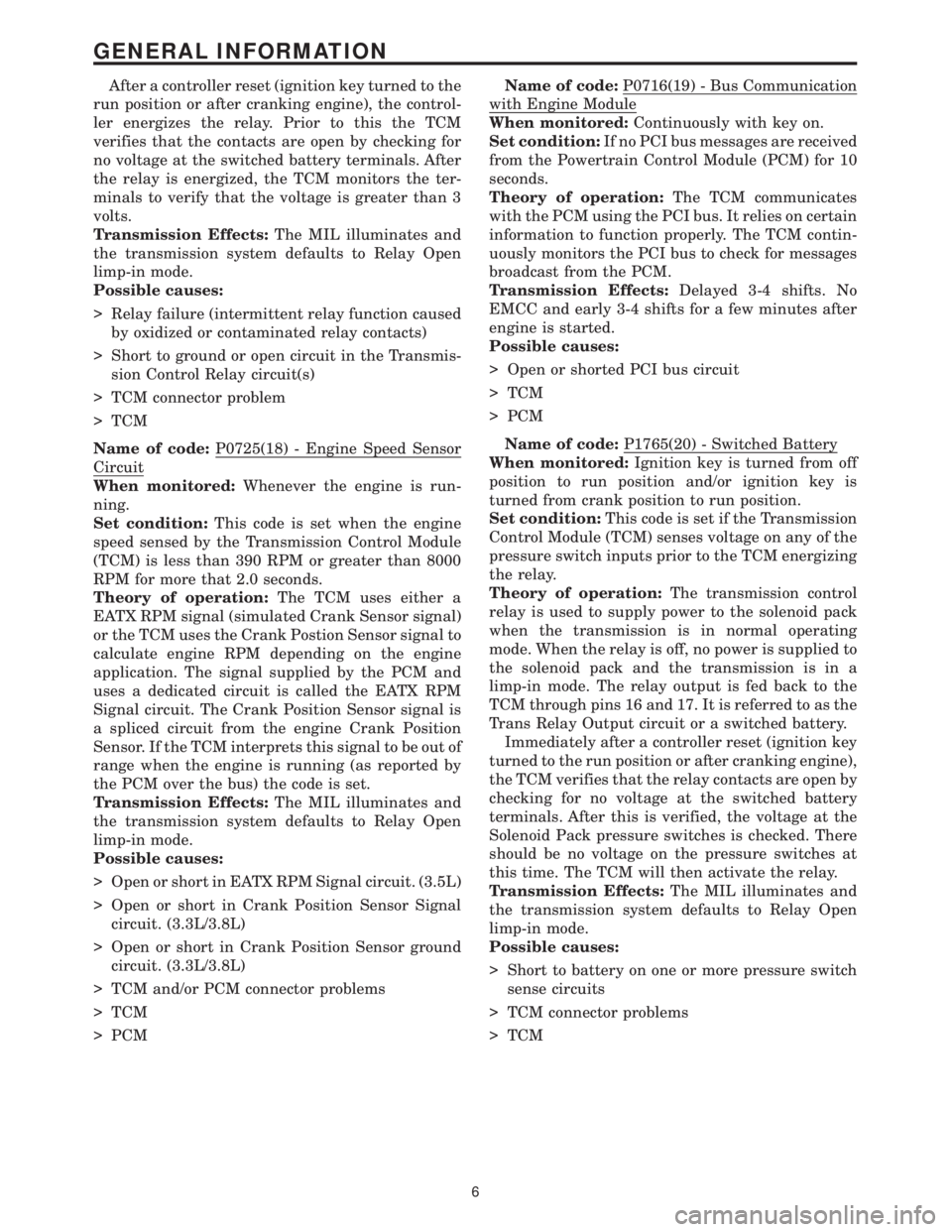
After a controller reset (ignition key turned to the
run position or after cranking engine), the control-
ler energizes the relay. Prior to this the TCM
verifies that the contacts are open by checking for
no voltage at the switched battery terminals. After
the relay is energized, the TCM monitors the ter-
minals to verify that the voltage is greater than 3
volts.
Transmission Effects:The MIL illuminates and
the transmission system defaults to Relay Open
limp-in mode.
Possible causes:
> Relay failure (intermittent relay function caused
by oxidized or contaminated relay contacts)
> Short to ground or open circuit in the Transmis-
sion Control Relay circuit(s)
> TCM connector problem
> TCM
Name of code:P0725(18) - Engine Speed Sensor
Circuit
When monitored:Whenever the engine is run-
ning.
Set condition:This code is set when the engine
speed sensed by the Transmission Control Module
(TCM) is less than 390 RPM or greater than 8000
RPM for more that 2.0 seconds.
Theory of operation:The TCM uses either a
EATX RPM signal (simulated Crank Sensor signal)
or the TCM uses the Crank Postion Sensor signal to
calculate engine RPM depending on the engine
application. The signal supplied by the PCM and
uses a dedicated circuit is called the EATX RPM
Signal circuit. The Crank Position Sensor signal is
a spliced circuit from the engine Crank Position
Sensor. If the TCM interprets this signal to be out of
range when the engine is running (as reported by
the PCM over the bus) the code is set.
Transmission Effects:The MIL illuminates and
the transmission system defaults to Relay Open
limp-in mode.
Possible causes:
> Open or short in EATX RPM Signal circuit. (3.5L)
> Open or short in Crank Position Sensor Signal
circuit. (3.3L/3.8L)
> Open or short in Crank Position Sensor ground
circuit. (3.3L/3.8L)
> TCM and/or PCM connector problems
> TCM
> PCMName of code:P0716(19) - Bus Communication
with Engine Module
When monitored:Continuously with key on.
Set condition:If no PCI bus messages are received
from the Powertrain Control Module (PCM) for 10
seconds.
Theory of operation:The TCM communicates
with the PCM using the PCI bus. It relies on certain
information to function properly. The TCM contin-
uously monitors the PCI bus to check for messages
broadcast from the PCM.
Transmission Effects:Delayed 3-4 shifts. No
EMCC and early 3-4 shifts for a few minutes after
engine is started.
Possible causes:
> Open or shorted PCI bus circuit
> TCM
> PCM
Name of code:P1765(20) - Switched Battery
When monitored:Ignition key is turned from off
position to run position and/or ignition key is
turned from crank position to run position.
Set condition:This code is set if the Transmission
Control Module (TCM) senses voltage on any of the
pressure switch inputs prior to the TCM energizing
the relay.
Theory of operation:The transmission control
relay is used to supply power to the solenoid pack
when the transmission is in normal operating
mode. When the relay is off, no power is supplied to
the solenoid pack and the transmission is in a
limp-in mode. The relay output is fed back to the
TCM through pins 16 and 17. It is referred to as the
Trans Relay Output circuit or a switched battery.
Immediately after a controller reset (ignition key
turned to the run position or after cranking engine),
the TCM verifies that the relay contacts are open by
checking for no voltage at the switched battery
terminals. After this is verified, the voltage at the
Solenoid Pack pressure switches is checked. There
should be no voltage on the pressure switches at
this time. The TCM will then activate the relay.
Transmission Effects:The MIL illuminates and
the transmission system defaults to Relay Open
limp-in mode.
Possible causes:
> Short to battery on one or more pressure switch
sense circuits
> TCM connector problems
> TCM
6
GENERAL INFORMATION
Page 4111 of 4284
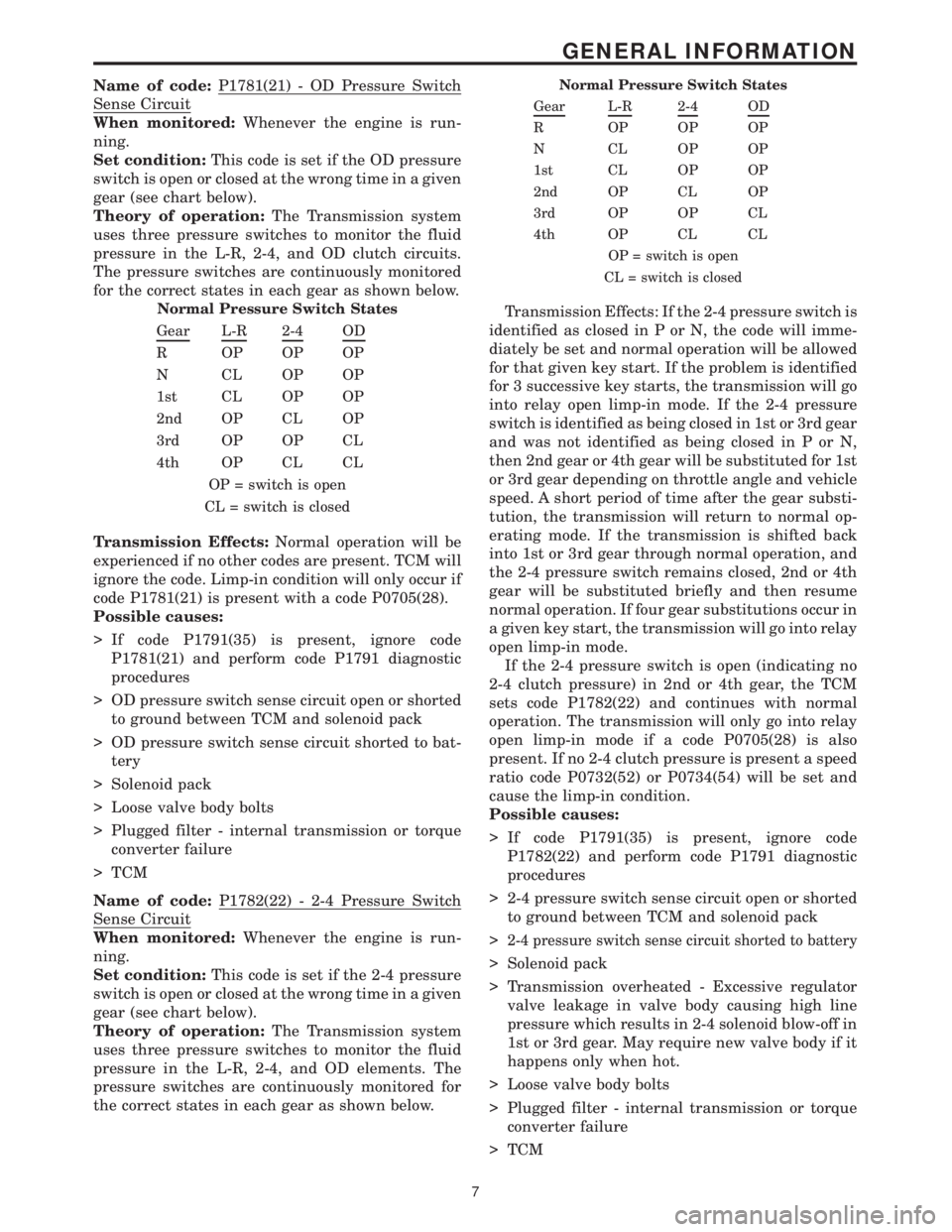
Name of code:P1781(21) - OD Pressure Switch
Sense Circuit
When monitored:Whenever the engine is run-
ning.
Set condition:This code is set if the OD pressure
switch is open or closed at the wrong time in a given
gear (see chart below).
Theory of operation:The Transmission system
uses three pressure switches to monitor the fluid
pressure in the L-R, 2-4, and OD clutch circuits.
The pressure switches are continuously monitored
for the correct states in each gear as shown below.
Normal Pressure Switch States
Gear
L-R2-4OD
R OPOPOP
NCLOPOP
1st CL OP OP
2nd OP CL OP
3rd OP OP CL
4th OP CL CL
OP = switch is open
CL = switch is closed
Transmission Effects:Normal operation will be
experienced if no other codes are present. TCM will
ignore the code. Limp-in condition will only occur if
code P1781(21) is present with a code P0705(28).
Possible causes:
> If code P1791(35) is present, ignore code
P1781(21) and perform code P1791 diagnostic
procedures
> OD pressure switch sense circuit open or shorted
to ground between TCM and solenoid pack
> OD pressure switch sense circuit shorted to bat-
tery
> Solenoid pack
> Loose valve body bolts
> Plugged filter - internal transmission or torque
converter failure
> TCM
Name of code:P1782(22) - 2-4 Pressure Switch
Sense Circuit
When monitored:Whenever the engine is run-
ning.
Set condition:This code is set if the 2-4 pressure
switch is open or closed at the wrong time in a given
gear (see chart below).
Theory of operation:The Transmission system
uses three pressure switches to monitor the fluid
pressure in the L-R, 2-4, and OD elements. The
pressure switches are continuously monitored for
the correct states in each gear as shown below.
Normal Pressure Switch States
Gear
L-R2-4OD
R OPOPOP
NCLOPOP
1st CL OP OP
2nd OP CL OP
3rd OP OP CL
4th OP CL CL
OP = switch is open
CL = switch is closed
Transmission Effects: If the 2-4 pressure switch is
identified as closed in P or N, the code will imme-
diately be set and normal operation will be allowed
for that given key start. If the problem is identified
for 3 successive key starts, the transmission will go
into relay open limp-in mode. If the 2-4 pressure
switch is identified as being closed in 1st or 3rd gear
and was not identified as being closed in P or N,
then 2nd gear or 4th gear will be substituted for 1st
or 3rd gear depending on throttle angle and vehicle
speed. A short period of time after the gear substi-
tution, the transmission will return to normal op-
erating mode. If the transmission is shifted back
into 1st or 3rd gear through normal operation, and
the 2-4 pressure switch remains closed, 2nd or 4th
gear will be substituted briefly and then resume
normal operation. If four gear substitutions occur in
a given key start, the transmission will go into relay
open limp-in mode.
If the 2-4 pressure switch is open (indicating no
2-4 clutch pressure) in 2nd or 4th gear, the TCM
sets code P1782(22) and continues with normal
operation. The transmission will only go into relay
open limp-in mode if a code P0705(28) is also
present. If no 2-4 clutch pressure is present a speed
ratio code P0732(52) or P0734(54) will be set and
cause the limp-in condition.
Possible causes:
> If code P1791(35) is present, ignore code
P1782(22) and perform code P1791 diagnostic
procedures
> 2-4 pressure switch sense circuit open or shorted
to ground between TCM and solenoid pack
>
2-4 pressure switch sense circuit shorted to battery
> Solenoid pack
> Transmission overheated - Excessive regulator
valve leakage in valve body causing high line
pressure which results in 2-4 solenoid blow-off in
1st or 3rd gear. May require new valve body if it
happens only when hot.
> Loose valve body bolts
> Plugged filter - internal transmission or torque
converter failure
> TCM
7
GENERAL INFORMATION
Page 4112 of 4284
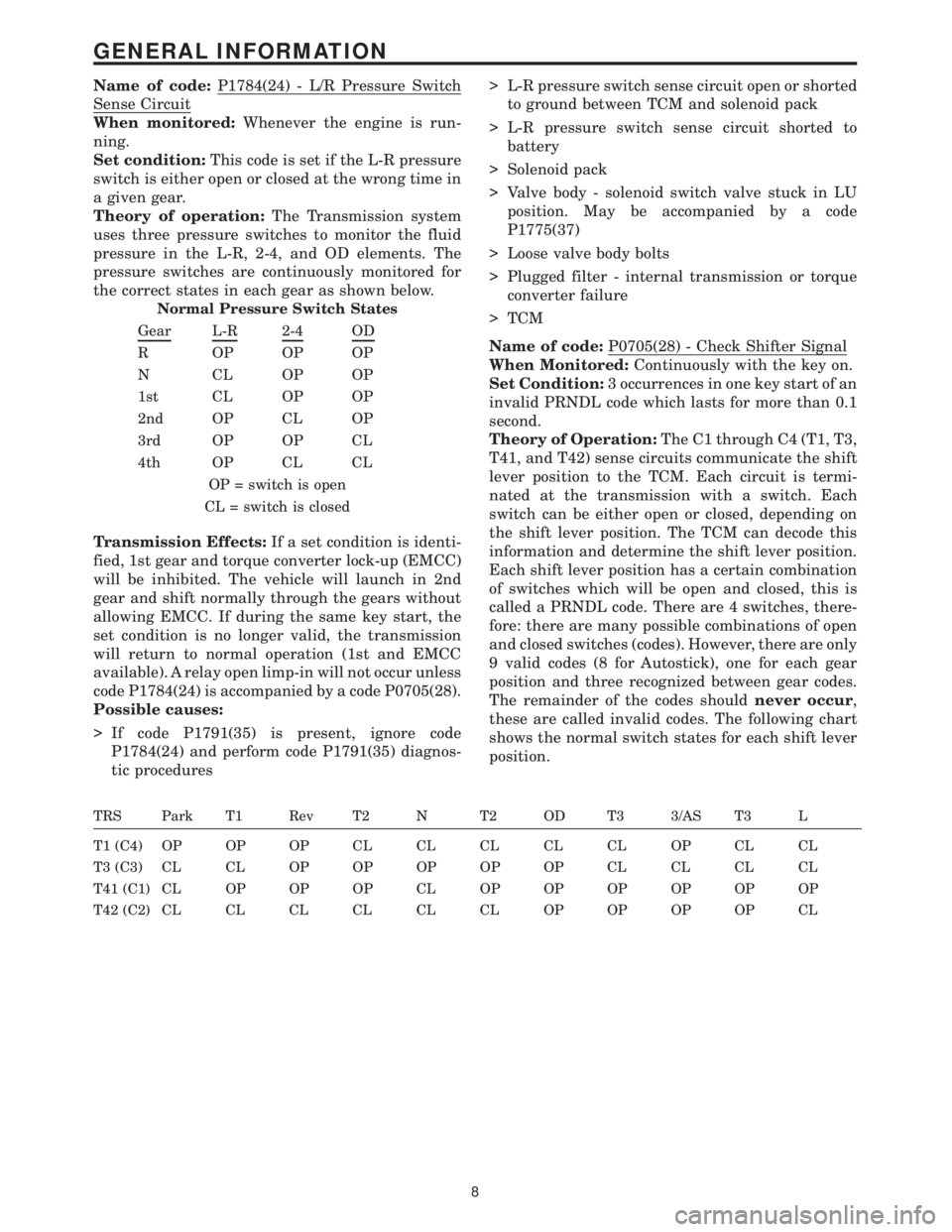
Name of code:P1784(24) - L/R Pressure Switch
Sense Circuit
When monitored:Whenever the engine is run-
ning.
Set condition:This code is set if the L-R pressure
switch is either open or closed at the wrong time in
a given gear.
Theory of operation:The Transmission system
uses three pressure switches to monitor the fluid
pressure in the L-R, 2-4, and OD elements. The
pressure switches are continuously monitored for
the correct states in each gear as shown below.
Normal Pressure Switch States
Gear
L-R2-4OD
R OPOPOP
NCLOPOP
1st CL OP OP
2nd OP CL OP
3rd OP OP CL
4th OP CL CL
OP = switch is open
CL = switch is closed
Transmission Effects:If a set condition is identi-
fied, 1st gear and torque converter lock-up (EMCC)
will be inhibited. The vehicle will launch in 2nd
gear and shift normally through the gears without
allowing EMCC. If during the same key start, the
set condition is no longer valid, the transmission
will return to normal operation (1st and EMCC
available). A relay open limp-in will not occur unless
code P1784(24) is accompanied by a code P0705(28).
Possible causes:
> If code P1791(35) is present, ignore code
P1784(24) and perform code P1791(35) diagnos-
tic procedures> L-R pressure switch sense circuit open or shorted
to ground between TCM and solenoid pack
> L-R pressure switch sense circuit shorted to
battery
> Solenoid pack
> Valve body - solenoid switch valve stuck in LU
position. May be accompanied by a code
P1775(37)
> Loose valve body bolts
> Plugged filter - internal transmission or torque
converter failure
> TCM
Name of code:P0705(28) - Check Shifter Signal
When Monitored:Continuously with the key on.
Set Condition:3 occurrences in one key start of an
invalid PRNDL code which lasts for more than 0.1
second.
Theory of Operation:The C1 through C4 (T1, T3,
T41, and T42) sense circuits communicate the shift
lever position to the TCM. Each circuit is termi-
nated at the transmission with a switch. Each
switch can be either open or closed, depending on
the shift lever position. The TCM can decode this
information and determine the shift lever position.
Each shift lever position has a certain combination
of switches which will be open and closed, this is
called a PRNDL code. There are 4 switches, there-
fore: there are many possible combinations of open
and closed switches (codes). However, there are only
9 valid codes (8 for Autostick), one for each gear
position and three recognized between gear codes.
The remainder of the codes shouldnever occur,
these are called invalid codes. The following chart
shows the normal switch states for each shift lever
position.
TRS Park T1 Rev T2 N T2 OD T3 3/AS T3 L
T1 (C4) OP OP OP CL CL CL CL CL OP CL CL
T3 (C3) CL CL OP OP OP OP OP CL CL CL CL
T41 (C1) CL OP OP OP CL OP OP OP OP OP OP
T42 (C2) CL CL CL CL CL CL OP OP OP OP CL
8
GENERAL INFORMATION